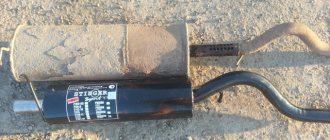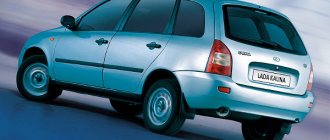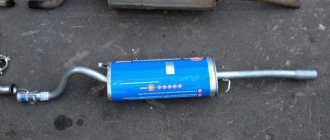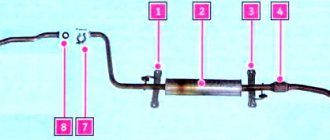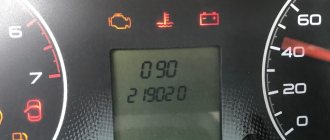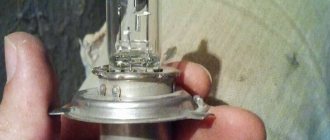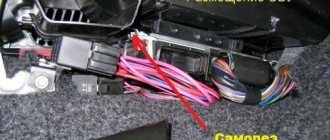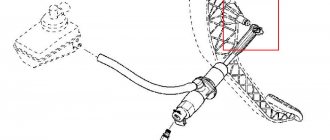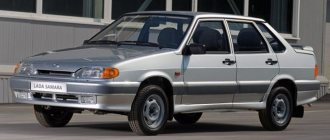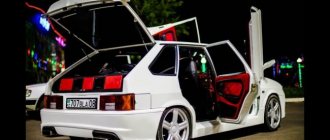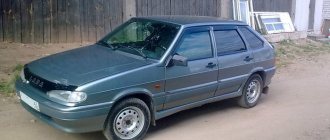VAZ 2114 engines
Below is a list of engines installed on the VAZ 2114 throughout the history of production.
- 1.5 liter 8 valve engine;
- 1.6 liter 8 valve engine;
- 1.6 liter 16 valve engine;
All engines have similar roots back to the distant 80s, namely with the 2108 engines. It was the eight engine that became the progenitor of all engines installed on modern VAZs.
This engine was distinguished by its reliability and maintainability.
Let's take a closer look at each of the engines.
Fuel consumption
Hatchbacks of this model are known for their efficiency. They consume little fuel, both on the highway and in the city. We invite you to compare the gasoline consumption of the VAZ 2114 for modifications with different types of power plants.
| Engine | Highway consumption l/100 km | Mixed mode, l/100 km | Urban cycle, l/100 km |
| 1.5l, 8-valve | 5,7 | 7,3 | 10,0 |
| 1.6l, 8-valve | 6 | 7,5 | 10,3 |
| 1.6 l, 16 valve | 5,4 | 7,2 | 9,8 |
Engine 2114 1.5 liter 8 valves
This engine was installed on the VAZ 2114 from the very beginning of production, namely from 2003 to 2007. It should be noted that the 1.5 liter engine was produced for some time in parallel with the 1.6 liter engine.
| Parameter | Meaning |
| Volume, (cm³) | 1496 |
| Power (hp) | 87 |
| Torque (Nm) | 115 |
| Injection | Injector |
| Number of cylinders | 4 |
| Ignition system | Ignition module |
| Fuel | AI-92 |
Engine Maintenance
The engine requires attention every 10-15 thousand mileage collimators. Upon reaching 10 thousand km. It is necessary to replace oils and filters, both oil and air.
Attention also needs to be paid to the timing belt. Although in this version the valve does not bend when it breaks, it is still advisable to carry out an inspection. On these models, the timing belt slips and is often eaten by rollers.
More information about this problem can be found in our article here.
Owner reviews
VAZ 2114 continued the tradition, and like its predecessor, it became a truly people's car. At one time it was the most affordable offer among non-mileage vehicles. This allowed it to become widespread and take its rightful place among other popular VAZ models.
Maksim. Lada 2114 1.6 l. 8th grade, 2010 180,000 km
I bought a car in 2015. The mileage on this example was quite decent, but the condition is good. I settled on the version with an 8-valve engine. Power is not so important for me, but they are considered much more reliable.
In general, this is confirmed so far. I only let you down once. When the temperature dropped below 30 degrees in winter, the battery died. But in fairness, it’s not entirely correct to make claims against the car itself.
Among the repair work, I did the replacement of the master brake cylinder and vacuum booster. We also had to change almost all the hoses under the hood. I recently had to replace the heater radiator. The rest is just consumables. I change the oil every 6-7 thousand, I only use synthetics. Many people do this on much higher mileages, but I like to play it safe. Moreover, given the quality of our fuels and lubricants, this will not be superfluous.
Among the shortcomings, we can note the quality of spare parts. Original spare parts from the factory do not serve flawlessly, but they have some margin of safety. Among the new ones there is a lot of different rubbish and defects. And this despite the fact that I try to buy the highest quality possible and not save. However, their “life” is very short. This is very frustrating and stressful. So I started thinking about selling.
Andrey. Lada 2114 1.6 l. 8th grade, 2008, 150,000 km
This car came to me unexpectedly. I was looking for a temporary second car for the family and settled on this option. I thought it wouldn’t be for long, but it turned out that I drove it for five years. All because I had to sell my main car. When purchased, the mileage was about 65 thousand.
There is not much to say about the ownership experience. A simple and unpretentious car. There are minimal amenities, but it doesn’t cause any trouble either. There is a minimum of electronics and electrics, and as a result it is quite reliable.
I didn’t have any breakdowns that would make it stand up straight on the road. I changed the clutch, replaced the timing belt and rollers three times (at my own request). Nothing more serious. I went for diagnostics a couple of times because the engine was not running very smoothly. Once we cleaned the throttle, and the second time we had to clean the injectors. I also replaced a rotten muffler.
Perhaps I would have kept it as a second car just in case, but it was starting to rot very actively. If not for this shortcoming, I would have given it a solid A. And so only four plus. For those who need a simple work machine for every day and are not too demanding, this is a very good option. The main thing is to find a specimen that is not killed or rotten through and through.
Nikolai. Lada 2114 1.5 l. 8th grade, 2006, 120 00 km
I purchased it in 2011 with 30,000 miles. The mileage is truly original, despite its age. I can say this for sure, since a friend had the car and was in plain sight all the time. I traveled for three years and did not know grief. I only changed consumables and all sorts of small things. But after the mileage exceeded 100 thousand, breakdowns began to appear.
First the stove stopped heating. Well, I thought it was a common thing: a thermostat or a faucet, but it’s not that simple. The antifreeze was slowly decreasing, but I thought it was coming from under the clamps somewhere, so I just added it little by little. Everything turned out to be much more serious. The temperature sensor was broken and was giving incorrect readings. That is, it showed normal temperature, but in fact it was overheating. It wasn’t actively boiling, but just a little bit at a time. Accordingly, the antifreeze gradually disappeared. As a result, such regular overheating gave me headaches. And minus the cylinder head gasket.
Then the ECU burned out. For some unknown reason. There is an opinion that the firmware is simply crooked. In the end I had to replace it. It cost, as they say, a pretty penny.
Well, little things somehow started to fall apart. And the quality of spare parts is absolutely poor. At least buy it in advance and rearrange everything around. Therefore, I sold it at 120 thousand. Perhaps I just came across an unsuccessful copy, because many people can easily ride for 200 thousand. But we need to clarify how much is being invested in repairs. I wasn’t happy with such fixed costs, so I decided to sell.
Judging by the mileage of 100 thousand, then everything is quite worthy, with the exception of corrosion resistance. Afterwards there is a big lottery. The car is suitable for those who love and know how to tinker themselves. The services turn out to be very expensive.
Engine 2114 1.6 liter 8 valves
This engine was installed on 2114 from 2003 to 2013. During its existence, the engine has undergone many changes. In 2010, cars with this engine began to be equipped with the E-GAZ system, that is, the accelerator pedal cable drive became electronic. AvtoVAZ engineers had to resort to this development due to the introduction of a new standard for the environmental safety of cars.
| Parameter | Meaning |
| Volume, (cm³) | 1596 |
| Power (hp) | 89 |
| Torque (Nm) | 125 |
| Injection | Injector |
| Number of cylinders | 4 |
| Ignition system | Ignition module |
| Fuel | AI-95 |
Engine Maintenance
This engine, like the previous one, requires attention every 10-15 thousand km. mileage It is necessary to replace oils and filters.
Acceleration to 100 km/h
Thanks to the light weight of the body, with its modest power data, the car turned out to be quite nimble. Even with the weakest power unit, it accelerates to 100 km/h quite quickly. The table presents comparative acceleration data for cars with different types of engines.
| Engine | Acceleration to 100 km/h, s |
| 1.5l, 8-valve | 13,2 |
| 1.6l, 8-valve | 13 |
| 1.6 l, 16 valve | 11,2 |
Engine 1.6 liter 16 valve
An engine with 16 valves was installed in a special series of VAZ 2114 cars called “SuperAuto”. This engine in the light body of the fourteenth model showed itself to be very worthy. The car has much improved dynamic characteristics compared to 8-valve engines.
| Parameter | Meaning |
| Volume, (cm³) | 1596 |
| Power (hp) | 92 |
| Torque (Nm) | 131 |
| Injection | Injector |
| Number of cylinders | 4 |
| Ignition system | Individual ignition coil for each cylinder |
| Fuel | AI-95 |
Engine Services
This engine, with 16 valves, received a serious flaw. When the timing belt breaks, the valves bend, which leads to very expensive repairs. Maintenance must be carried out every 10 thousand km. This includes changing oils and filters, as well as inspecting timing components for earlier detection of possible malfunctions.
We hope our article was useful to you.
Design
All modifications of the engine installed on the VAZ 2114 have a block cast from cast iron and a fuel injection system. Despite the design solutions used to improve dynamic and environmental performance, the design of the VAZ 2114 engine has retained its simplicity and reasonable maintenance cost.
Operation and resource availability
An oil change should be done every 9-11 thousand km. Regardless of the modification, 3.2 liters will be required to change the oil. Recommended viscosity: 5W-30, 10W-40, 5W-40, 15W-40.
According to the manufacturer, the engine life is 150 thousand km. (200 thousand km for Priora motor). Practice has shown that with proper maintenance, the engine can cover up to 250 thousand km.
Failure to comply with maintenance standards and improper tuning of the VAZ 2114 engine significantly reduces its service life.
Features and Disadvantages
1.5l:
- after a timing belt breaks, the valves remain unharmed;
- Regular adjustment of valve clearances is required;
- wear of cooling system components;
- oil leaks from under the valve cover;
- oil leakage from under the ignition distributor and fuel pump;
- poor fastening of the exhaust manifold (solved by replacing steel nuts with brass ones);
- unreliability of early injection systems.
1.6l:
- A broken timing belt does not deform the valve;
- the need for periodic valve adjustment;
- increased noise and vibration load.
16V 1.6i l (124):
- Thanks to the holes on the pistons, even with moderate sports shafts, if the timing belt breaks, the valves do not bend;
- Every 15 thousand km you need to tighten the timing belt.
16V 1.6i l (126):
- a broken timing belt leads to bending of the valves (the problem can be solved by installing plug-free pistons.
Popular faults
Due to the imperfect quality of the unit and the large number of low-quality spare parts, the motor and attachments require increased attention.
Main problems and possible causes:
- Unstable idling of the VAZ 2114, the engine stalls after starting. Cause – Coking of the idle speed controller (IAC), throttle position sensor, vacuum seal “drizzle”, unreliable signals from the mass air flow sensor;
- Starting has deteriorated, the engine is running rough - the reason may be: incorrect valve adjustment, lack of compression in one of the cylinders (the valve may have burned out), wear of the valve springs, air leaks (check the connections of the hoses and pipes going after the mass air flow sensor and to the vacuum valve, valve hose purging of the absorber, tight fit of the injectors to the cylinder head), malfunction of the ignition module, spark plugs do not produce a spark, inoperability of high-voltage wires, incorrect valve timing (the timing belt may have slipped a few teeth);
- The VAZ 2114 engine has lost throttle response and does not pull. The breakdown is possible due to a malfunction of the ignition module (symptoms appear when the engine is warm), a clogged catalyst, the fuel pump does not create the required pressure, a dirty air filter, air leaks, carbon deposits on the spark plugs, lack of compression;
- Extraneous knocking, noise and vibration of the VAZ 2114 engine. Breakdown may occur because valve clearances need adjustment, sagging valve springs, sagging seats, wear of the main bearings of the crankshaft or connecting rod bearings (it is possible that the pistons themselves are knocking), hydraulic compensators, wear of the engine mounts (pillows);
- Does not show the engine temperature of the VAZ 2114. Occurs due to a malfunction of the coolant temperature sensor (the sensor screwed into the cylinder head is responsible for the readings on the instrument panel), open circuit, oxidation of contacts, a malfunction in the indicator on the dashboard;
- The engine is heating up. Thermostat failure (liquid circulates only in the engine cooling jacket). When buying a thermostat, look in the instructions for what engine operating temperature it is designed for (for the engines in question this is 95-103 degrees); Damage to the water pump impeller, malfunction of the fan switch sensor, or the fan itself does not work.
ADVANTAGES AND DISADVANTAGES
ADVANTAGES OF THE MACHINE
- Good aerodynamics;
- Pleasant appearance;
- Quite fast power plants;
- Acceptable ride height;
- In high esteem among the young population;
- Lots of possibilities for various improvements;
- Already the base car has a small and stylish rear spoiler;
- Front-wheel drive;
- Good stability;
- Bumpers painted to match the body color;
- Good wear resistance of the suspension;
- More pleasant europanel;
- There is an on-board computer;
- Heated front seats;
- Price;
- Electric windows;
- Cast wheels with the possibility of installing “rollers” of larger diameter;
- Adjustable steering column;
- Ease of repair;
- Low fuel consumption.
DISADVANTAGES OF THE CAR
- Door handles often fail;
- The bumpers are also very easy to break since they are plastic;
- The car rots very quickly, it is necessary to treat it with a primer yourself, since the manufacturing company missed this;
- There's not much space inside;
- Low level of security;
- No air conditioning or power steering;
- Poor build quality;
- Hard plastic front panel;
- Small luggage compartment.
Lowriders movement
What is the trunk volume of the Lada Kalina station wagon in liters? The Low Rider movement originated 60 years ago in the USA.
In Russia, it has only now become relevant for car enthusiasts, and is especially popular among young people. “Low Riding” is a lowering of the car’s suspension; the lower the car “lies”, the better. "Lada 2114" was no exception in this style. After shortening the suspension spring, the car becomes more stable. The appearance of the car is not for everybody; many criticize the style of lowered cars.
Also newfangled was the installation of air suspension on the fourteenth family. The advantage of this suspension is that the ground clearance can be adjusted. The cost of air suspension reaches 100,000 rubles.
As a rule, only original and branded wheels are installed on the car, or even left on standard wheels. Thousands of drivers spend a lot of money on modifying the “fourteenth”. In the photo, the Lada 2114 is presented in a lowered version.
TECHNICAL CHARACTERISTICS OF THE FOURTEENTH
First, let's look at the main characteristics of the VAZ 2114.
The fourteenth model is a 5-door hatchback, with the following body dimensions (mm): L – 4112, W – 1650, H – 1402. Vehicle weight – 970 kilograms, maximum loading weight – 470 kg.
The wheelbase of the VAZ 2114 is similar to the nine - 2460 mm, the track between the front wheels is 1400 mm, the rear - 1370 mm. In all modifications, the fourteenth has a front drive axle. Ground clearance between the body pan and the road is 170 mm.
The car is equipped with a 5-speed manual transmission with the following gear ratios:
- First speed – 3.636;
- Second – 1.95;
- Third – 1.357;
- Fourth – 0.941;
- Fifth – 0.784;
- Reverse – 3.53.
The fuel tank of the fourteenth holds 43 liters of gasoline. The fuel recommended by the manufacturer is AI95.
The VAZ 2114 has front disc brakes and drum brakes at the rear. The braking distance of a loaded car at a speed of 80 km/h is 38 meters.
The VAZ 2114 was produced with two engine options - 8 and 16 valves. All the differences between them are discussed in detail in the last section of the article.
Changes to the car compared to its predecessor
In the updated model, not only the external part of the car has radically changed, but the interior has also been significantly updated.
External differences from its predecessor:
- Bumper. The bumper became higher and was painted in body color, like foreign cars; before it, the 10, 11 and 12 models could boast of this.
- Headlights. The headlights became smaller and more rounded, and the optics themselves were quite modern at that time.
- Rear spoiler. Some trim levels were equipped from the factory with a small spoiler that did not differ in color from the car.
- Radiator trim and hood. The hood also differed favorably from its angular predecessor with its rounded shape, which made the 2114's design quite fresh.
- Wings . Slots for turn signals appeared in the wings and, in general, they began to integrate more advantageously into the overall appearance of the car.
- Side skirt fairings. The sills began to be covered with plastic covers and painted the same color as the body.
- Moldings. The moldings go along the doors and are in turn painted to match the color of the car's body.
All this made the VAZ 2114 quite attractive and modern, which, coupled with its low price, promised success for the model. The changes, by the way, did not affect the rear of the car, although initially the engineers planned to change the appearance of the rear lights. The idea was abandoned due to unreasonable increases in production costs.
Looking into the salon, you can find updated:
- Torpedo. The new torpedo was made according to European standards and lost the second glove compartment in the luxury configuration. The plastic has become less creaky than in the nine.
- Dashboard . Although not new, since the instrument panel was already installed on the VAZ 2110, it migrated here, unlike the old one, it had a more modern appearance.
- Steering wheel and steering column. The fourteenth model was equipped with a new, at that time, steering wheel from a VAZ 2110, and a knob for adjusting it appeared on the steering column.
- The seat belt fastenings have found their highest points.
Sitting in the restyled cabin has become much more pleasant and comfortable, and many additional pleasant goodies have appeared, such as:
- electric window lifters;
- heated seats;
- air conditioner;
- fog lights;
- central door locking;
- standard on-board computer;
- alloy wheels and tinting.
There were only two configurations available: basic and luxury. They did not differ much in both price and equipment. The luxury one had a plastic cover on the engine for decoration, a plastic receiver and a standard on-board computer.
Story
This machine has its own path, its own line, which it has successfully bent and continues to do so. She doesn't want to deviate from her trajectory of success, and the producers wanted to do just that. She lives like in the samurai code. She lives, but thinks she is dead. Of course, it is no longer produced; the last release from the assembly line of the Volzhsky Automobile Plant was back on December 24, 2013. However, they still drive it to this day and love it just like they did in those days. Everyone saw her off: they wrote sad songs and words, there were farewell events for the owners of this car. After all, it is a mark in history, and the white Lada 2114, and its manufacturers understand this very well. And their decision to stop creating the machine can be understood: it has lived its life, squeezed the maximum out of itself. And, of course, we need to give way to young people who are as promising as the white Lada-2114 in its time. At one time, half of the Russian Federation rode it, and it was normal.
Golden mean
In those days they understood that people needed to be given their choice. So that they understand, it is better to choose a chic look, “show-off” or modesty and rational options and body features. It is worth noting that young people really like Soviet cars, because they can be easily learned to drive. They are difficult to operate, but this is how the VAZ-2114 taught millions of citizens of the Russian Federation to drive. And they learned to drive it precisely because it was the most affordable, best and most profitable among other domestic cars.
Suspension upgrade
What year Gazelle and with which engine is better
Basic characteristics of the VAZ-211440 has a good suspension that allows you to drive on Russian roads without any problems. However, fine tuning will make it stiffer, for which you need to get high-quality shock absorbers. In order to reduce roll angles, it is recommended to install rigid anti-roll bars.
Don't forget about the wheels if you're planning on tuning the suspension. The visual component comes to the fore. For the “fourteenth” there is a wide variety of alloy wheels available in many specialty stores and markets.
What problems do “14s” have with mileage?
Young people, as a rule, get the most out of their cars, which is why there are a lot of damaged cars on the secondary market. Here is a live example, you don’t even need to look closely:
The avtocod.ru report shows that the car was involved in accidents three times:
In all three cases, the impact fell on the same part of the body:
The car was issued a copy of the title, there are restrictions on registration with the traffic police.
Another problem with used “fourteeners” is the twisted mileage. Here's a live example:
The mileage in the ad is 150 thousand km, in the report it is 146,343 km:
But in fact, the car has driven more than 200 thousand km:
This car is pretty tired and will probably require repairs. Better to look for something else.
The body of the fourteenth model and its features
What color wheels will go with a blue car?
ATTENTION! A completely simple way to reduce fuel consumption has been found! Don't believe me? An auto mechanic with 15 years of experience also didn’t believe it until he tried it. And now he saves 35,000 rubles a year on gasoline! Read more". We are talking about a car assembled on a standard VAZ platform
The car is a 5-door, front-wheel drive, hatchback body type. In front, and in general, the shape of the car frame is distinguished by good AED* characteristics and a modern, practical design
We are talking about a car assembled on a standard VAZ platform. The car is a 5-door, front-wheel drive, hatchback body type. In front, and in general, the shape of the car frame is distinguished by good AED* characteristics and a modern, practical design.
Thanks to the numerous options included by the manufacturer, driving the machine is quite comfortable. We can say that there is no unnecessary function or detail on the fourteenth model, and the body is made in a unique style. A new design of front optics, a different radiator lining, a different hood and moldings - all this was fully introduced into the domestic auto industry with the release of the VAZ 2114.
As for the interior, there is also a lot of innovation here. The steering column is adjustable, although the design of the “steering wheel” as a whole does not differ from the appearance of its analogues (installed with “tens”). The heater and front STPD* received a new design.
Initially, the fourteenth model moves into the category of cars of a new class, as close as possible to foreign cars. On the other hand, 2114 still remains a people's car, corresponding to the individual needs of the owner. If it occurs to a motorist to carry out tuning, then the VAZ 2114 turns into a real sports car, distinguished by an expressive body kit and sweeping body lines.
As for the main standard size, the body length of the VAZ 2114 is 4006 mm. Despite the fact that this is a hatchback, the luggage compartment is quite large - 330 liters. If you fold the rear seats, the trunk will be twice as large.
Trying to please the consumer, the manufacturer introduced many different original body elements. These were plastic body kits, moldings, etc. In addition, as mentioned, the design of the front optics was changed. On the fourteenth model, there are already four headlights in front.
It is the car body that should be considered separately, as it is a true example of design art. As on other VAZ models, parts of the VAZ 2114 body are connected to each other either by welding or bolts. The body is well treated with anti-corrosive, even in the most inaccessible places.
The main difference between the body of the fourteenth model and its analogues is its faceted shape. This gives the car, of course, a lot of originality, but this shape has a negative effect on the condition of the body. The fact is that it is easier for corrosion to penetrate into the hollow spaces of the frame. The front pillars of the VAZ 2114 especially often suffer.
